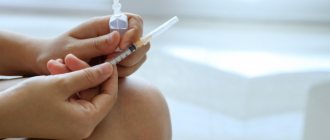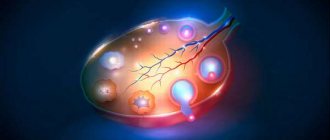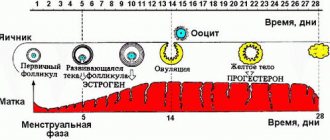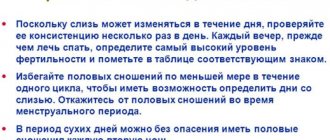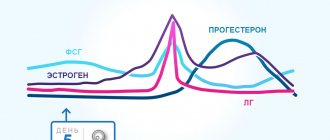If a woman has problems conceiving, then after examination by a gynecologist and finding out the cause of infertility, treatment with hormonal drugs may be prescribed. They are needed to stimulate ovulation when follicles do not mature in the ovaries for some reason.
The selection of hormonal drugs and their dosage occurs strictly individually. The purpose of stimulating ovulation is the formation in a woman’s body of one or more eggs capable of fertilization. The use of drugs such as Clostilbegit and Proginova for this purpose has become the most common method of treating the causes of infertility.
Characteristics of the drug
Clostilbegit is a drug of the antiestrogenic group, the main active ingredient of which is Clomiphene, supplemented with excipients such as stearic acid, gelatin, magnesium stearate, lactose monohydrate, potato starch and talc.
The scheme for stimulating ovulation with Clostilbegit is always determined by the doctor, based on the available data of each individual patient, but the mechanism of action of the drug is always the same and consists in the specific binding of the main component to the estrogen receptors of the pituitary gland and ovaries.
Moreover, if the natural content of estrogen in the body is low, the drug enhances the production of the hormone, bringing its levels to normal, and if the content of the hormone is increased, its production is suppressed.
It is important to strictly observe the correct dosage, not allowing it to be exceeded, since with normal and small doses of the drug, when the established scheme is strictly followed, stimulation of ovulation by Clostilbegit occurs in a normal manner, due to the increased natural secretion of gonadotropins, such as LH, FSH and prolactin, which causes stimulation process.
But when the required doses are exceeded, the secretion of gonadotropins is inhibited.
In some cases, the drug can also be prescribed to men during systematic monitoring of spermatograms.
Reviews
Women who became pregnant after stimulation with Clostilbegit note that the effectiveness of the drug declared by the manufacturers is somewhat different from the real one. Thus, the highest chances of pregnancy were, oddly enough, not during stimulation, but in the intervals between two three-month courses, when the drug was temporarily stopped.
Many during this period used products such as Divigel externally, applying 3-4 mg of it to the skin. After the delay, many women who were stimulated to ovulate and injected with human chorionic gonadotropin on the right day had difficulty diagnosing pregnancy. The results of the blood test were overestimated in terms of the concentration of this hormone.
A negative test due to a delay in menstruation was also not always true, since some had late ovulation, despite stimulation. True, this happens rarely.
Unfortunately, stimulation of ovulation sometimes ends not only in a favorable pregnancy. Sometimes an egg that was literally forced out of the follicle is not completely healthy and cannot ensure a normal pregnancy. The “error” creeps in at the gene level at the very beginning, and then most often, after stimulation, a miscarriage occurs in the early stages.
There are a sufficient number of reviews of women on the Internet for whom this drug did not help get pregnant at all. The desired effect was achieved only after a full rest after the first stimulation and a repeat procedure, but with other medications.
To learn how drugs to stimulate ovulation affect a woman’s body, watch the following video.
medical reviewer, psychosomatics specialist, mother of 4 children
Our rulers of planners. Try it and tell us what you think!–>
* Dear friends! Yes, this is an advertisement, you have to spin like that!
Good afternoon Yesterday we started stimulating ovulation, I have MF, we are planning a second baby. I would like to ask who managed to get pregnant on the drugs Proginova 1t*2 times + Clostilbegit 2t*1 time. What are my chances? She was the first to become pregnant in a natural cycle after two flights of insemination and stimulation with puregon. but then there weren’t any of our own at all, now there are delays, but our own
Read 4 comments:
I was able to stop the third time, the endometrium was not growing well from progynov, I increased the dose myself. You need to look at the growth of your follicles to talk about the chances. Although I had 3-4 DF for all 3 stimulations. So good luck to you. I’m the opposite, the first child was stimulated, the second one turned out on its own. So please mom's heterosexuals on you
I got pregnant on the clost. The first stimulation was unsuccessful, I drank 1 t / 2 r.d. From 5 to 9 dmc and apparently it was a large dose, there was early ovulation at 7 dmc, we didn’t even notice it and that’s it, but in the second cycle I already took 1 tablet a day and everything worked out, plus I went for folliculometry and got an hCG injection 10 thousand units at 11 dmc, because the follicle had grown and they were afraid that it would burst and develop into a cyst.
added after 3 minutes
I forgot to add, the endometrium at the time of conception was 5 mm, I am on Utrozhechtan 2 times a day at 200. Divigel did not help me build up much, the uzist generally said that it was decreasing every day. but everything happened!
I found my post about stimulation 1 stim. 5-9 dC Clostilbegit 1 t at night (you never know what side effects it has to feel good during the day) I started taking estrogens a little late, that is, smearing my belly with Divigel, because the endometrium was very small... I smeared it until 25 DC, 1 sachet in the morning/evening... It didn’t help me (I tracked dominant follies using ultrasound, then an injection of hCG 10,000, I wanted it to rot, but we don’t have it anywhere. As a result, at 16, DC confirmed ovulation and waited for the end of the cycle... The injection came out somewhere - then after 11 days. Flight cycle. 2nd stage. 5-9 dC Clostilbegit 1 t at night. Since Divigel did not help, I took estrogen Proginova 1 tablet per day. The endometrium was not growing well, the doctor said to increase it to 2 -x times. But somehow it also grew rather weakly, in the end I was already taking 2 tablets 2 times a day (prescribed for myself). I took Proginova until 14 DC. Again I gave an injection of hCG 10,000, at 16 DC I confirmed ovulation. The injection went out at 8 D.O. Passage again. 3rd stim. 5-9 dC Clostilbegit 1 t at night. Because the endometrium was not growing well, I started drinking 2 tablets at once. 2 times a day Proginova. As a result, the endometrium grew me I was upset, only 6 mm, and in the last cycle it was 8.5, I started taking risks and drank 3 tablets for several days. at a time. At 14 DC End. 6 mm, PY 2F 20 and 21 mm, LY 2F 17 and 18... I give an injection of hCG 10,000... But on this day I drank wine. At 16 DC, ovulation was not confirmed, the injection is necessary again, but already 5000 and the follicles have grown in PL 2 DF 21 and 22 mm, in PL 1 DF 21 mm, end. still 6 mm (((I continued to take Proginova for several days, drank everything that was left. As a result, in the 3rd cycle I drank 2 packs of Proginova. The 16th dc fell on the NG, I didn’t drink anything alcoholic... But in this cycle I decided to relax a little and drank beer 3 times, 0.5 in total, but still)) on the night before Christmas, after the PA I felt a pain in the LA, then went down the abdomen and uterus, the pain was contractions... it was very painful, it lasted for more than an hour. At 8 DPO I took a test to see the hCG output, there was a faint line. A day later I did another one, it became brighter, every day it became brighter.
Read more Why are periods pink?
Before prescribing medicinal stimulants, the woman undergoes a full course of examination, as does her sexual partner. The true reason for the lack of egg release is determined, and only then the doctor selects individual ovulation stimulation schemes for each person.
Indications for use
The drug is used to treat many diseases, for example:
- Induction of ovulation, called anovulatory infertility.
- Dysgonadotropic form of amenorrhea.
- Dysfunctional metrorrhagia.
- Galactorrhea caused by a pituitary tumor.
- Amenorrhea of secondary type.
- Amenorrhea that occurs after the use of contraceptives.
- Stein-Leventhal syndrome. In this case, ovulation is stimulated with Clostilbegit for polycystic ovary syndrome.
- Androgen deficiency.
- Chiari-Frommel syndrome.
- Oligospermia.
- Disorders of the gonadotropic function of the pituitary gland and their diagnosis.
Clostilbegit and proginova
Taking clostilbegit can inhibit estrogen production, which causes thickening of cervical mucus, which is an obstacle to sperm penetration.
To avoid such an undesirable effect, doctors often prescribe a regimen for stimulating ovulation with clostilbegit and proginova.
Proginova complements the ovulation stimulation scheme with clostilbegit
Proginova is indicated under the following conditions:
- thin endometrium;
- decrease in estrogen in the blood;
- with previous miscarriages.
Proginova maintains the hormone level at the desired level, helps the endometrium acquire the desired thickness and brings cervical mucus into a state that promotes the advancement of male cells in the fallopian tubes. The drug is prescribed only by a doctor in individual doses. The course of treatment lasts from 5 to 21 days of the cycle. It should be remembered that this medicine cannot be taken with other estrogens, so as not to cause ovarian dysfunction.
Release form and cost
The drug is available in tablets, each of which contains 50 mg of active substance. The tablets are placed in dark glass bottles of 10 pieces, and then in cardboard packaging.
The cost of the product varies and ranges from 550 to 800 rubles per package. Analogues of the drug include: Clomiphene, Serophene, Clomid, Pergotime and Serpafaf.
How does the drug work and does it help you get pregnant?
The action of clomiphene, the main component of the drug, is aimed at increasing the pituitary gland's production of hormones responsible for sexual function. The purpose of the drug is to activate and accelerate the maturation of the follicle with a healthy egg.
Taking Clostilbegit is usually combined with other drugs that support normal hormonal levels. In simple words, women who do not ovulate, after taking Clostilbegit, get a chance to conceive.
Did you know? Initially, the drug Clostilbegit , synthesized in the 1950s, was intended as a contraceptive. However, after the negative effect, a number of studies were conducted... and in 1967 it was included in the complex for the treatment of infertility.
Use of the drug
Stimulation of ovulation by Clostilbegit, the scheme of which has its own peculiarities, is prescribed mainly to women with existing infertility of unknown or endocrine origin, in cases where independent ovulation is absent.
Before starting treatment with the drug, it is necessary to be examined and eliminate some causes of infertility, if any. These include:
- Male factor. A man who has problems getting pregnant should have a spermogram before stimulation, since with a reduced fertility rate the chances of fertilization will be very low even if ovulation occurs. Read more about male infertility→
- Endometrial disorders. It is necessary to check the endometrium for possible injuries after an intrauterine device or abortion, mucosal polyps, endometriosis or endometritis. Any of these disorders will interfere with the implantation of the embryo into the uterus.
- Pipe factor. Normal tubal patency is very important when planning pregnancy, so a woman needs to undergo a special examination before stimulation. Read more about tubal infertility→
- Cervical factor, which is a physiological incompatibility of partners, in which sperm die on the cervix.
In addition, there are conditions when a woman needs special treatment and proper correction, for example:
- Hyperprolactinemia, in which there is a high level of prolactin.
- Hypothyroidism, which is a disorder of the thyroid gland, a decrease in its natural function.
- Incorrect diagnosis of anovulation. It is important to remember that it is not possible to determine the absence of ovulation by using test strips or charting. To make such a diagnosis, it is necessary to carry out ultrasound monitoring of ovulation over several cycles of at least 4–5.
In these cases, the use of the drug is unjustified. But there are also cases when conception does not occur due to lack of sexual contact at the required time. For example, doctors very often recommend that couples planning a pregnancy have sex from the 10th to the 14th day of the menstrual cycle, since during this period the likelihood of conception is maximum.
But in fact, the moment of ovulation is individual for each woman, and it is not at all uncommon that for many women this happens later or earlier than the average dates established by doctors.
The advantages of the drug include:
- its effectiveness and high efficiency. Most women manage to solve the problem from the first course;
- cost of the product. Clostilbegit is by far the cheapest drug in this category.
The disadvantages are that:
- the drug must be taken with a product containing estrogen, so most often women are prescribed ovulation stimulation with Clostilbegit and Proginov, which entails additional costs almost equal to the cost of the main drug;
- there are side effects. Many patients note the appearance of dizziness and nausea on days 2-4 of therapy;
- it is necessary to monitor the therapy using ultrasound performed every other day;
- it is important to stop taking the drug in time as soon as the follicle grows to the required size, so the number of tablets taken for each woman will be different;
- Stimulation with the drug cannot be carried out for more than three menstrual cycles in a row;
- You cannot stimulate ovulation with Clostilbegit more than 6 times during your life.
Analyzes and examinations
Certain risks cannot be excluded when stimulating ovulation . Hyperstimulation, multiple pregnancies, etc. may occur.
The cost of the procedure should also be taken into account. For these reasons, before the procedure, many tests and studies are prescribed that help identify contraindications to Clostilbegit therapy, prescribe preliminary hormonal treatment, select the right dosage and regimen to create optimal conditions, minimal health risks and a successful attempt.
- So, a woman should undergo a survey and clinical examination, during which the following is established:
- Pathologies of a mammographic nature (breast), mastopathy, thrombo-embolic diseases.
- Duration of the menstrual cycle (with a short cycle, an FSH test should be taken on the 2-3rd day of the cycle; if it increases, stimulation is contraindicated).
- Body mass index (allows you to refer for further research into the causes of problems with ovulation).
- After this, the woman needs to undergo an HSG - a study that is necessary before stimulation. It consists of checking the patency of the fallopian tubes. If there are adhesions or inflammatory processes, stimulation cannot be done. The doctor will select treatment to eliminate this cause.
- A compatibility test is also mandatory regardless of the diagnosis. Most often it is carried out for further purpose of stimulation with artificial insemination.
- A spermogram allows you to exclude male factor infertility and assess sperm motility, their number and morphology.
- It is also necessary to undergo a test for antibodies against rubella, since this disease has a detrimental effect on the development of the fetus.
- Hormonal examination at the beginning of the cycle on days 3-5 is very important:
- FSH . This hormone will show ovarian reserve. When its levels are low, problems lurk in the pituitary gland or hypothalamus, and when it is slightly elevated, we can talk about the beginning of ovarian resistance. In the second case, preliminary treatment is carried out. If the FSH level is high, then stimulation is not performed.
- LG . If the level is low, the doctor will suspect a deficiency of pituitary activity. High numbers are assessed in relation to FSH: with a difference of more than 1.4 (FSH is greater than LH), the ovarian response to stimulation will be good; with numbers below 0.5, a weak response is possible.
- Prolactin . A very capricious hormone, the indicators of which are influenced by many factors: stress, fear of injections, etc. In this case, the numbers may be high. To achieve reliable results, you should follow the rules, which you can learn from your doctor.
- Inhibin B. This test has recently been introduced to assess ovarian reserve, but studies show that this test is not needed, as patients with low rates have about 27% of pregnancies.
- Estradiol . Predicts ovarian response. When its level is high, the formation of follicles accelerates and the ovaries are depleted.
- If your LH levels are low, your doctor may order a GnRH test.
- Ultrasound must be performed at the beginning of the cycle on days 5-6 before stimulation. In addition to identifying abnormalities, the study helps determine the type and type of ovaries:
- micro-polycystic (in the presence of 10 or more small follicles in both ovaries with a dense membrane);
- multifollicular (a large number of follicles with normal membrane density);
- exhausted (less than 4 cells in the ovary);
- normal (differ in parameters from the types described above).
- In case of polycystic ovaries, examinations for insulin resistance are prescribed, which improves the chances of pregnancy.
After all the examinations, the doctor selects the desired protocol. It depends on the readings of FSH, LH to FSH and the type of ovaries.
The basic rules for using Clostilbegit include the following points::
- You cannot treat yourself with the drug.
- Before starting the course, the doctor must evaluate hormonal levels.
- During stimulation, the following conditions should be monitored:
- liver;
- ovaries;
- vagina;
- cervix.
- When using Clostilbegit, you should refrain from driving a vehicle and work that requires increased attention.
Application diagram
The drug is prescribed before ovulation from days 2–5 of the menstrual cycle, which depends on its length, 1 tablet at night for 5 days. Ultrasound is an obligatory part of therapy and is necessary to monitor the result obtained, as well as to monitor the growth rate of the dominant follicle (or several) and the condition of the endometrium.
When stimulating ovulation with Clostilbegit, an hCG injection is given as soon as the follicle reaches a size of 20–25 mm. The dosage of the substance is determined by the doctor, but in most cases it ranges from 5,000 to 10,000 IU. This is necessary to prevent regression of follicle development, as well as the formation of a follicular cyst.
Ovulation in most cases occurs one day after the hCG injection, which makes it possible to accurately calculate the moment favorable for conception; however, the rhythm of sexual activity during stimulation is determined by the doctor, based on the available data of both spouses.
After the presence of ovulation is confirmed, the doctor prescribes maintenance therapy with gestagens, both tablets and injections.
2 weeks (on the 14th day) after ovulation, a woman’s blood is taken to determine the level of hCG and the presence of pregnancy.
After confirmed ovulation, pregnancy tests are not recommended for 12 days, as the result may be false negative.
When stimulating ovulation with Clostilbegit and Proginov, the scheme remains the same. The drug Proginova is prescribed in cases where a woman has estrogen deficiency, which affects the condition of the endometrium and its thickness.
Endometrial disorders can lead to rejection of the fertilized egg by the internal cavity of the uterus, therefore, for maximum effectiveness, the drugs are prescribed in pairs.
Scheme for stimulating ovulation with gonal
Ovulation is often stimulated by gonal, the dosage regimen of which is also individual. It is considered safer and more effective than clostilbegit.
This drug, like follicle-stimulating hormone, regulates the menstrual cycle and ovulation, helps restore disrupted hormonal levels and the ability of the ovaries to reproduce eggs. It is used in the first 7 days of the cycle, that is, from the day of menstruation. Further prescription is regulated by the doctor. The duration of the course depends on the size of the follicle. When it reaches 18 mm according to ultrasound, it usually stops taking it. Stimulation can last up to two weeks, but stops 2-3 days before cell maturity, so that after this period hCG is administered.
If the problem was identified correctly and Gonal was used according to indications, then conception can be achieved after the first course.
Contraindications
Since each tablet of the drug contains 100 mg of lactose, taking the drug is contraindicated for people with galactose intolerance, glucose malabsorption, or lactase deficiency.
In addition, contraindications are:
- Hypersensitivity.
- Pregnancy.
- Kidney or liver failure.
- Ovarian cyst.
- Matrorrhagia of unknown etiology.
- The presence of neoplasms in the genital area.
- Hyperprolactinemia and resulting ovarian failure.
- Endometriosis.
- Hypofunction or tumor of the pituitary gland.
Preparation for the procedure
When planning a pregnancy and there is no ovulation, before undergoing a treatment course with Clostilbegit, a woman undergoes a number of examinations:
- test to determine hormone levels;
- Ultrasound of the reproductive system;
- examination of the uterine mucosa;
- tests for the presence of infections (including sexually transmitted infections);
- examination of the fallopian tubes;
- test for compatibility with a partner plus his spermogram.
Without such preparation, without indicators of the level of female and male hormones, not a single qualified doctor will prescribe a course of stimulation with Clostilbegit or Clomiphene Citrate.
Side effects
The drug can have an effect on different systems of the body, causing adverse reactions on their part. Side effects from digestion include nausea, flatulence, vomiting and diarrhea, and gastralgia.
From the nervous system, headaches and severe dizziness, depression, insomnia or drowsiness, increased excitability, irritability, and a slowdown in the speed of motor and mental reactions often appear.
The reaction of the genitourinary system can be considered an increase in urination, menorrhagia, dysmenorrhea, the appearance of pain in the lower abdomen, ovarian cystosis (increase in size). In some cases, polyuria may occur.
Allergic reactions when taking the drug occur extremely rarely, manifesting themselves in the form of vasomotor disorders, dermatitis and rash.
In addition, adverse reactions may include the appearance of “hot flashes” in the face, weight gain, pain in the mammary glands, alopecia and a slight decrease in visual acuity.
After stopping therapy, all side symptoms disappear on their own within a few days.
Stimulating ovulation with Clostilbegit is a very serious undertaking that can only be prescribed by a doctor. Under no circumstances should you prescribe such measures for yourself.
To carry out stimulation and the normal start of pregnancy, you need to contact a good clinic with qualified specialists who will not only conduct a full examination, but will also carefully monitor the therapy process and its results, taking all the required measures in a timely manner.
Carrying out stimulation on your own can be dangerous and have very disastrous consequences.
Author: Irina Vaganova, doctor, especially for Mama66.ru
Additional recommendations
In preparation for stimulation of the ovulatory cycle, a woman undergoes a detailed examination. Sometimes taking Clostilbegit never starts, because inflammatory and some hormonal problems that lead to ovarian dysfunction can be solved at the preparatory stage, by providing the woman with the necessary therapy.
Recommendations for weight regulation are often sufficient: by losing just 5% of the original weight, a woman significantly increases her chances of becoming a mother, and her ovulation is restored naturally. Similar recommendations also apply to women with insufficient body weight - weight correction and increasing it to the optimal level can be very effective.
Many people are familiar with the anxiety and worries associated with unsuccessful attempts to get pregnant. Doctors recommend calming down and relaxing, and not perceiving unsuccessful attempts as a great personal tragedy.
Read more When did the cure for the plague appear?
If stress and “obsession” with the problem do not follow a woman around, her hormonal levels will change for the better, and ovulation will most likely be restored.
In any case, many women became pregnant this way - when they were already desperate, when they no longer expected and were not nervous about the inability to conceive.
Who and why should not resort to such therapy?
In most cases, Clostilbegit is prescribed to patients who are unable to conceive a child on their own due to problems with the functioning of the ovaries, with polycystic ovary syndrome and in anticipation of the IVF procedure. As you know, the treatment regimen for each woman is drawn up individually, but only if there are no contraindications.
Situations in which therapy with Clostilbegit is contraindicated:
- gastrointestinal diseases;
- pathologies in the excretory system (kidney and liver diseases);
- ovarian cyst;
- presence of sexually transmitted infections;
- tumors of the reproductive system, pituitary gland;
- endometriosis, others.
Also, before using drug therapy (injections, tablets) with Clostilbegit, it is advisable for patients to familiarize themselves with the list of side effects. They often resemble symptoms of hormonal imbalance:
- pain in the head, lower abdomen;
- sudden hot flashes;
- sleep problems;
- weight gain;
- urge to vomit;
- loss of strength or, conversely, excessive excitability;
- discomfort in the mammary glands;
- flatulence, diarrhea;
- allergy.
How quickly does the effect occur?
In approximately 13–15% of patients, ovulation occurred in the first cycle of using the product. For other patients, the doctor increases the dose of the drug. After the initial dose of the drug was increased, ovulation was induced in another quarter of the women.
It is not always possible to induce ovulation with this drug
However, even with the maximum dosage, there are still patients in whom it is not possible to “induce” ovulation. This amount is not large - about 10%. These women are prescribed a special course of treatment with Clostilbegit.





